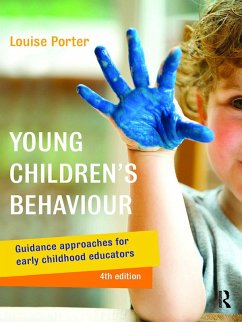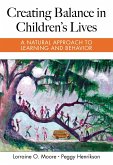- Gebundenes Buch
- Merkliste
- Auf die Merkliste
- Bewerten Bewerten
- Teilen
- Produkt teilen
- Produkterinnerung
- Produkterinnerung
An evidence-based text for pre-service teachers explaining how to develop children's capacity for self-regulation in childcare settings and early years of school.
Andere Kunden interessierten sich auch für
![Consent in the Childhood Classroom Consent in the Childhood Classroom]() Clio StearnsConsent in the Childhood Classroom178,99 €
Clio StearnsConsent in the Childhood Classroom178,99 €![Hitting Pause Hitting Pause]() Gail Taylor RiceHitting Pause170,99 €
Gail Taylor RiceHitting Pause170,99 €![Training Teachers in Emotional Intelligence Training Teachers in Emotional Intelligence]() Elena SavinaTraining Teachers in Emotional Intelligence168,99 €
Elena SavinaTraining Teachers in Emotional Intelligence168,99 €![Creating Balance in Children's Lives Creating Balance in Children's Lives]() Lorraine O MooreCreating Balance in Children's Lives26,99 €
Lorraine O MooreCreating Balance in Children's Lives26,99 €![Contemplative Practices and Anti-Oppressive Pedagogies for Higher Education Contemplative Practices and Anti-Oppressive Pedagogies for Higher Education]() Contemplative Practices and Anti-Oppressive Pedagogies for Higher Education34,99 €
Contemplative Practices and Anti-Oppressive Pedagogies for Higher Education34,99 €![Sexuality for All Abilities Sexuality for All Abilities]() Katie ThuneSexuality for All Abilities140,99 €
Katie ThuneSexuality for All Abilities140,99 €![School Commercialism School Commercialism]() Alex MolnarSchool Commercialism49,99 €
Alex MolnarSchool Commercialism49,99 €-
-
-
An evidence-based text for pre-service teachers explaining how to develop children's capacity for self-regulation in childcare settings and early years of school.
Produktdetails
- Produktdetails
- Verlag: Taylor & Francis
- 4th edition
- Seitenzahl: 504
- Erscheinungstermin: 31. März 2021
- Englisch
- Gewicht: 1090g
- ISBN-13: 9780367720193
- ISBN-10: 0367720191
- Artikelnr.: 73389788
- Herstellerkennzeichnung
- Libri GmbH
- Europaallee 1
- 36244 Bad Hersfeld
- gpsr@libri.de
- Verlag: Taylor & Francis
- 4th edition
- Seitenzahl: 504
- Erscheinungstermin: 31. März 2021
- Englisch
- Gewicht: 1090g
- ISBN-13: 9780367720193
- ISBN-10: 0367720191
- Artikelnr.: 73389788
- Herstellerkennzeichnung
- Libri GmbH
- Europaallee 1
- 36244 Bad Hersfeld
- gpsr@libri.de
An adjunct senior lecturer at Flinders University, Dr Louise Porter is a child psychologist with 35 years' experience of working with children. A sought-after international speaker, she is also the author of many books including A Comprehensive Guide to Classroom Management, Parental Guidance Recommended and Gifted Young Children.
Introduction
1. Principles of early years education
2. Principles of behaviour guidance
3. Needs
4. Understanding emotions
5. Providing a child-centred program: mastery and accomplishment
6. Meeting children's basic needs: survival, safety and wellbeing
7. Meeting children's need for self-esteem: competence and worth
8. Meeting children's need to belong: care and connection
9. Meeting children's need for autonomy: voice and choice
10. Influences on behaviour
11. Listening to children
12. Everyday guidance practices
13. Supporting children's self-regulation
14. Solving persistent problems
15. Solutions to children's emotional difficulties
16. Solutions to children's social difficulties
17. Interventions for children with atypical development
18. Collaboration with parents
Resources
Notes
Bibliography
Index
1. Principles of early years education
2. Principles of behaviour guidance
3. Needs
4. Understanding emotions
5. Providing a child-centred program: mastery and accomplishment
6. Meeting children's basic needs: survival, safety and wellbeing
7. Meeting children's need for self-esteem: competence and worth
8. Meeting children's need to belong: care and connection
9. Meeting children's need for autonomy: voice and choice
10. Influences on behaviour
11. Listening to children
12. Everyday guidance practices
13. Supporting children's self-regulation
14. Solving persistent problems
15. Solutions to children's emotional difficulties
16. Solutions to children's social difficulties
17. Interventions for children with atypical development
18. Collaboration with parents
Resources
Notes
Bibliography
Index
Introduction
1. Principles of early years education
2. Principles of behaviour guidance
3. Needs
4. Understanding emotions
5. Providing a child-centred program: mastery and accomplishment
6. Meeting children's basic needs: survival, safety and wellbeing
7. Meeting children's need for self-esteem: competence and worth
8. Meeting children's need to belong: care and connection
9. Meeting children's need for autonomy: voice and choice
10. Influences on behaviour
11. Listening to children
12. Everyday guidance practices
13. Supporting children's self-regulation
14. Solving persistent problems
15. Solutions to children's emotional difficulties
16. Solutions to children's social difficulties
17. Interventions for children with atypical development
18. Collaboration with parents
Resources
Notes
Bibliography
Index
1. Principles of early years education
2. Principles of behaviour guidance
3. Needs
4. Understanding emotions
5. Providing a child-centred program: mastery and accomplishment
6. Meeting children's basic needs: survival, safety and wellbeing
7. Meeting children's need for self-esteem: competence and worth
8. Meeting children's need to belong: care and connection
9. Meeting children's need for autonomy: voice and choice
10. Influences on behaviour
11. Listening to children
12. Everyday guidance practices
13. Supporting children's self-regulation
14. Solving persistent problems
15. Solutions to children's emotional difficulties
16. Solutions to children's social difficulties
17. Interventions for children with atypical development
18. Collaboration with parents
Resources
Notes
Bibliography
Index
Introduction
1. Principles of early years education
2. Principles of behaviour guidance
3. Needs
4. Understanding emotions
5. Providing a child-centred program: mastery and accomplishment
6. Meeting children's basic needs: survival, safety and wellbeing
7. Meeting children's need for self-esteem: competence and worth
8. Meeting children's need to belong: care and connection
9. Meeting children's need for autonomy: voice and choice
10. Influences on behaviour
11. Listening to children
12. Everyday guidance practices
13. Supporting children's self-regulation
14. Solving persistent problems
15. Solutions to children's emotional difficulties
16. Solutions to children's social difficulties
17. Interventions for children with atypical development
18. Collaboration with parents
Resources
Notes
Bibliography
Index
1. Principles of early years education
2. Principles of behaviour guidance
3. Needs
4. Understanding emotions
5. Providing a child-centred program: mastery and accomplishment
6. Meeting children's basic needs: survival, safety and wellbeing
7. Meeting children's need for self-esteem: competence and worth
8. Meeting children's need to belong: care and connection
9. Meeting children's need for autonomy: voice and choice
10. Influences on behaviour
11. Listening to children
12. Everyday guidance practices
13. Supporting children's self-regulation
14. Solving persistent problems
15. Solutions to children's emotional difficulties
16. Solutions to children's social difficulties
17. Interventions for children with atypical development
18. Collaboration with parents
Resources
Notes
Bibliography
Index
Introduction
1. Principles of early years education
2. Principles of behaviour guidance
3. Needs
4. Understanding emotions
5. Providing a child-centred program: mastery and accomplishment
6. Meeting children's basic needs: survival, safety and wellbeing
7. Meeting children's need for self-esteem: competence and worth
8. Meeting children's need to belong: care and connection
9. Meeting children's need for autonomy: voice and choice
10. Influences on behaviour
11. Listening to children
12. Everyday guidance practices
13. Supporting children's self-regulation
14. Solving persistent problems
15. Solutions to children's emotional difficulties
16. Solutions to children's social difficulties
17. Interventions for children with atypical development
18. Collaboration with parents
Resources
Notes
Bibliography
Index
1. Principles of early years education
2. Principles of behaviour guidance
3. Needs
4. Understanding emotions
5. Providing a child-centred program: mastery and accomplishment
6. Meeting children's basic needs: survival, safety and wellbeing
7. Meeting children's need for self-esteem: competence and worth
8. Meeting children's need to belong: care and connection
9. Meeting children's need for autonomy: voice and choice
10. Influences on behaviour
11. Listening to children
12. Everyday guidance practices
13. Supporting children's self-regulation
14. Solving persistent problems
15. Solutions to children's emotional difficulties
16. Solutions to children's social difficulties
17. Interventions for children with atypical development
18. Collaboration with parents
Resources
Notes
Bibliography
Index








